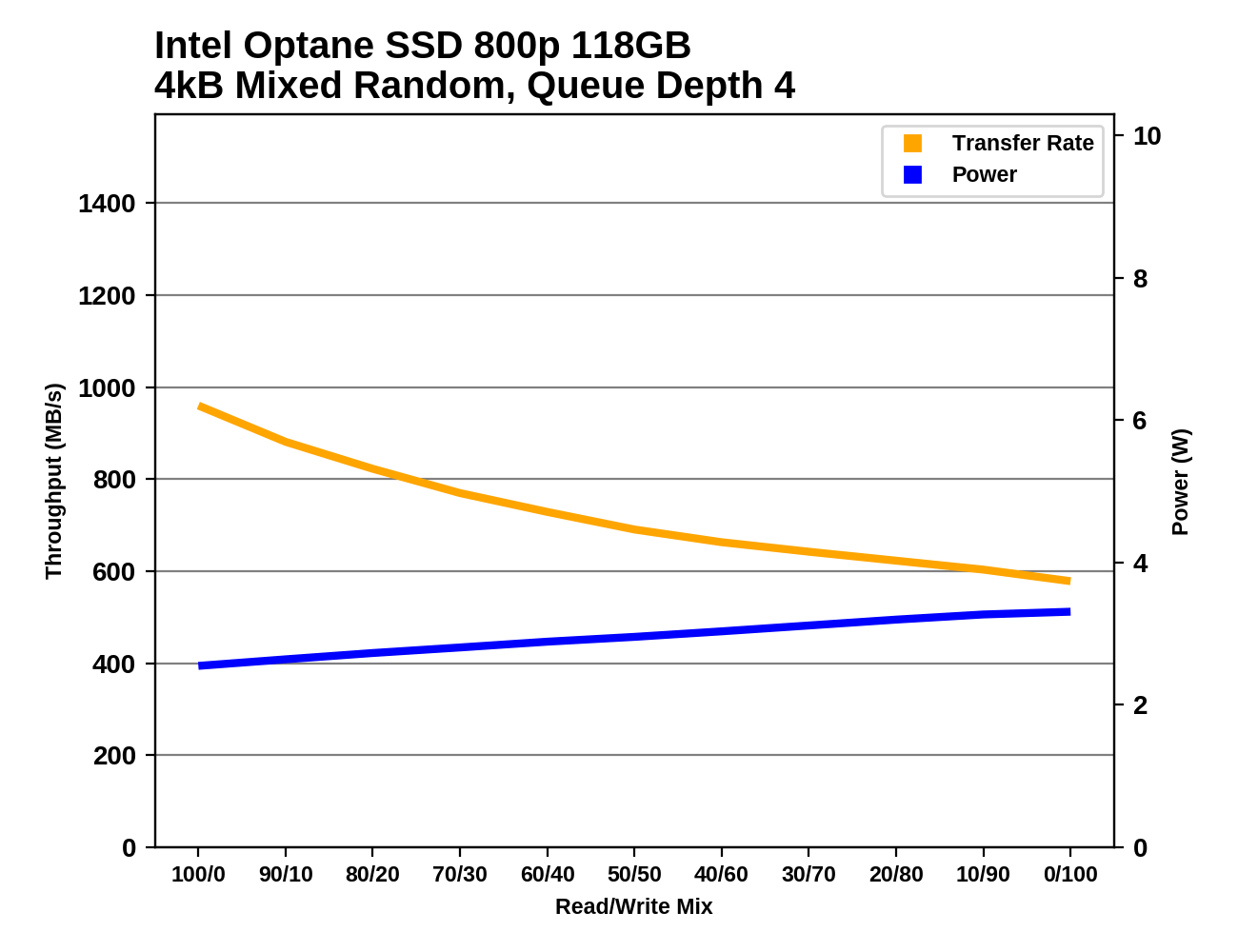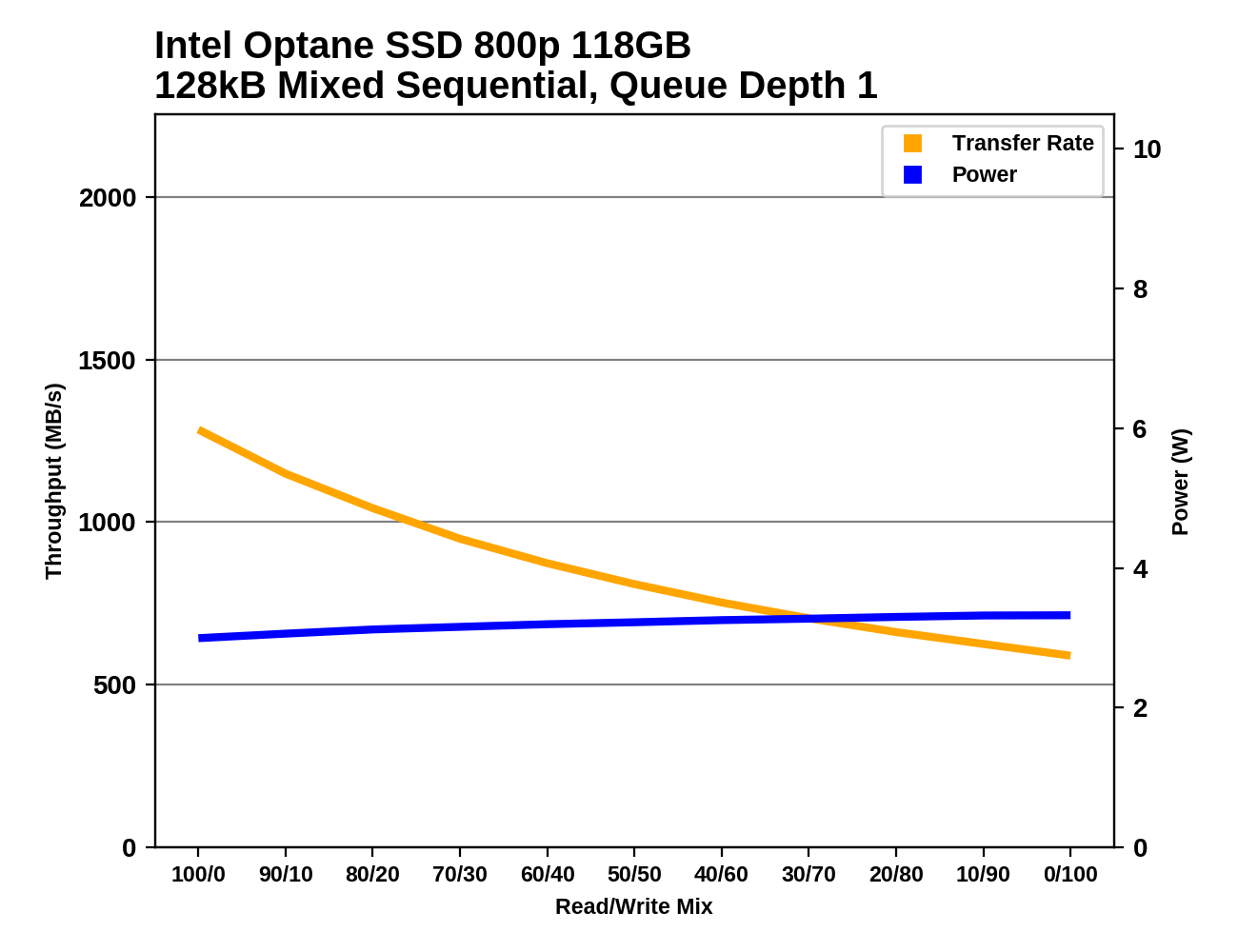The Intel Optane SSD 800p (58GB & 118GB) Review: Almost The Right Size
by Billy Tallis on March 8, 2018 5:15 PM ESTMixed Random Performance
Our test of mixed random reads and writes covers mixes varying from pure reads to pure writes at 10% increments. Each mix is tested for up to 1 minute or 32GB of data transferred. The test is conducted with a queue depth of 4, and is limited to a 64GB span of the drive. In between each mix, the drive is given idle time of up to one minute so that the overall duty cycle is 50%.

The Optane SSDs put even Samsung's best NVMe SSDs to shame on the mixed random I/O test. The 800p is a little more than half as fast as the 900p, which is plenty to put it far out of reach of the flash-based SSDs.

The Optane SSD 800p takes first place for power efficiency on the mixed random I/O test, with the 58GB model having a slight advantage over the 118GB due to the lower power consumption of operating half as many 3D XPoint dies. The flash-based SSDs come close to matching the efficiency of the Optane SSD 900p, but are far behind the 800p.
 |
|||||||||
With no write buffering, the Optane SSDs show a steady decline in performance as the proportion of writes increases, with no spike in performance at the end as is typical of flash-based SSDs with aggressive write combining. The 800p shows a more pronounced reduction in performance than the 900p, while the 900p's power consumption climbs more.
Mixed Sequential Performance
Our test of mixed sequential reads and writes differs from the mixed random I/O test by performing 128kB sequential accesses rather than 4kB accesses at random locations, and the sequential test is conducted at queue depth 1. The range of mixes tested is the same, and the timing and limits on data transfers are also the same as above.

With only a PCIe x2 interface and sequential write speeds that only use a fraction of that bandwidth, the Optane SSD 800p is actually performing pretty well on the mixed sequential I/O test. The 800p has the same average performance as Samsung's fastest TLC SSD, and offers more than two thirds the performance of the Samsung 960 PRO.

The power efficiency of the Intel Optane SSD 800p is second only to that of the Samsung 960 PRO. The 800p's efficiency score is far above the 900p and the low-end NVMe SSDs.
 |
|||||||||
As with the mixed random I/O test, the Intel Optane SSD 800p shows a steady decline inn performance as more writes are added to the mix. The decline is steeper than the one shown by the 900p. Power consumption increases very slightly over the course of the test but still stays within the rated maximum.










116 Comments
View All Comments
name99 - Friday, March 9, 2018 - link
Not QUITE true.Apple has done it (IMHO very successfully) in part because
- they understand something of the data patterns and
- already had tech in the file system to move hot data (hot file system data AND hot files) to the fastest part of the medium and
- they were willing to include ENOUGH flash (128GB) and fast flash; they didn't cheap out.
But yeah, the solutions sold by Seagate were not (in my experience) very impressive, especially considering the ridiculous premium Seagate charged for them.
What you CAN do on Apple systems (and I have done, very successfully, multiple times) is to fuse external SSDs with other drives (either other external or an internal HD) and this behaves just like a native fusion drive, you can even boot off it. This means you can retrofit fusion even to old macs (eg I have a 2007 iMac running a fusion system based on an SSD in an external FW-800 enclosure, fused with the internal 320GB drive).
zepi - Friday, March 9, 2018 - link
Sounds like Apple Fusion drive. Very difficult to do well on drive-level, much easier to do well with some OS support and filesystem level.Afaik people have been relatively happy with their Fusion drives, though personally I find them horribly expensive. Then again, that applies to all Apple storage options, they always feel insanely expensive.
PeachNCream - Friday, March 9, 2018 - link
Optane performance is good in some ways and disappointing in others. I'd like to see the technology improve since NAND endurance is a problem that warrants a solution. Maybe Optane isn't that solution.Reflex - Friday, March 9, 2018 - link
Optane basically is a variation of Phase-Change Memory. It's been around a long time, but Micron/Intel have finally managed to make it in large enough capacities to productize it out of niche markets. There are other contenders for next gen memory &storage, ranging from MRAM (magnetic memory) to ReRAM to racetrack memory (HP has claimed to be on the edge of productizing that for about four years now).I am just happy one finally got out there, an it is in pretty good shape for a first gen product. Hoping this gets others to get serious about bringing alternative storage methods to market soon.
Lolimaster - Saturday, March 10, 2018 - link
At least the 860 EVO and Pro improved endurance a lot for consumer.600TB 860 EVO 1TB
1.2PB 860 Pro 1TB
leexgx - Sunday, March 11, 2018 - link
they can easy do 4x that especially the Pro drive (they was been Really conservative before, mainly so it did not affect the sales of there enterprise drives)heck the 840 Pro did was 2PB before it died suddenly (but it did all that with 0 read errors)
Araemo - Friday, March 9, 2018 - link
Can we get the consistency scatter plots for this drive? Those are an awesome tool to gauge the real world 'feel' of the drive.Billy Tallis - Friday, March 9, 2018 - link
They're an awesome tool to exaggerate the impact of garbage collection pauses on flash-based SSDs. Real-world usage doesn't involve constant writes to a full drive. Those random write consistency graphs often show interesting things about how drives handle GC, but they're a horrible way of ranking real-world performance of SSDs.Zinabas - Saturday, March 10, 2018 - link
As a thought the best case to use these in... would be an AMD Ryzen system with (Fuzedrive) the new software that manages all the drives as one volume. The small capacity would be automanaged by software and would be swapped to fit whatever you're playing at the time.emvonline - Monday, March 12, 2018 - link
so there doesnt seen to be a clear difference in real world applications. its faster with lower latency but does not always show up. could you cleary pick the optane drive vs samsung 960 in a blind test everytime running games and office apps?